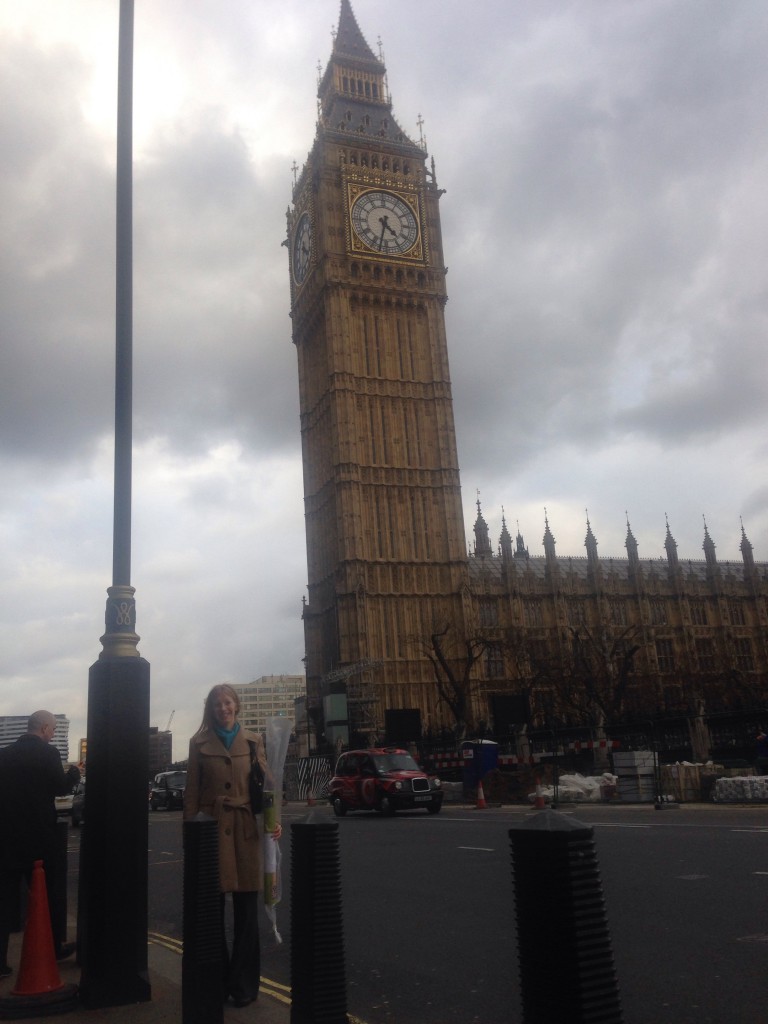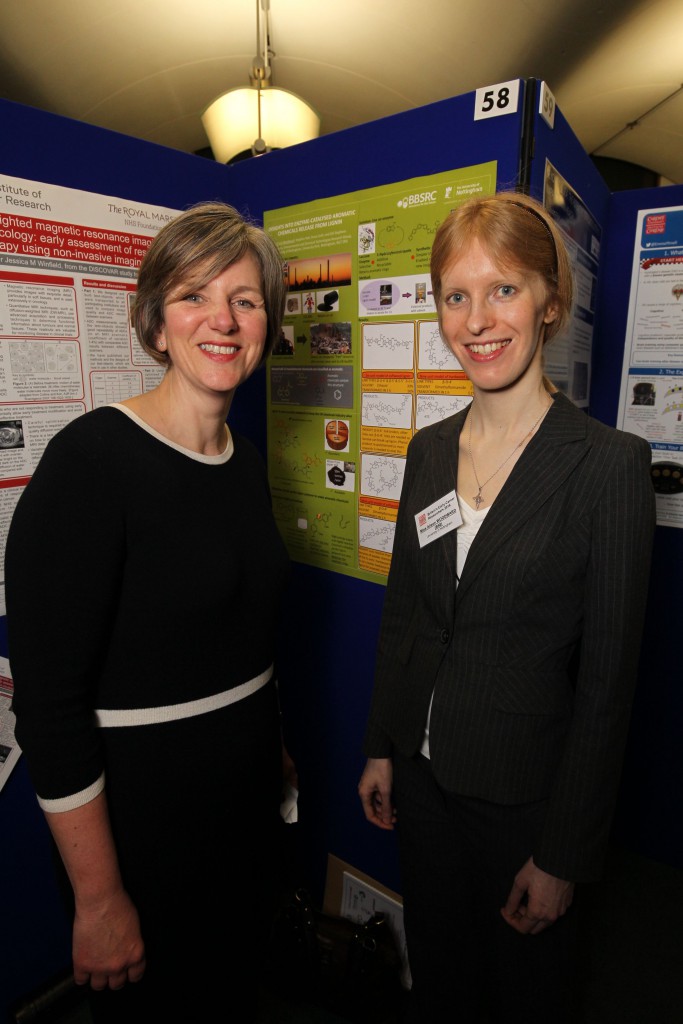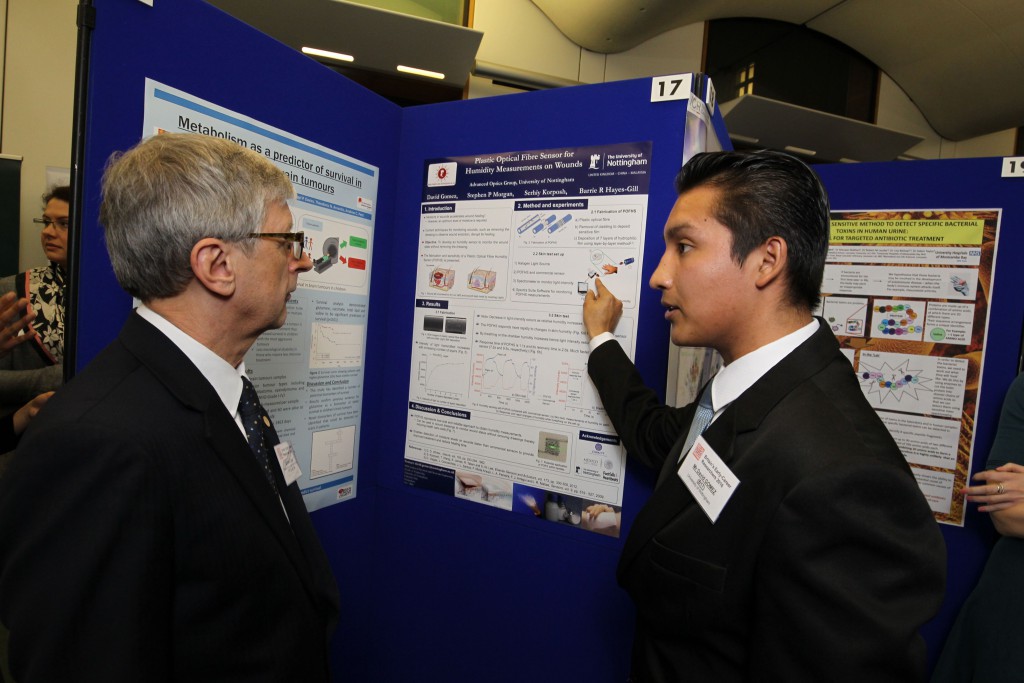April 6, 2016, by Michael Jennings
Students engage MPs with scientific research
PhD students from the Faculty of Engineering had the opportunity to present their research at the House of Commons before Members of the Parliament and the wider research community on 7 March.
They attended the annual SET For Britain research showcase, held in Portcullis House, a government building opposite Westminster Palace. SET is short for Science, Engineering and Technology, but also encompassed maths and biomedicine.
The showcase is organised by the Parliamentary and Scientific Committee to enable postgraduate students / postdoctoral researchers and MPs to meet each other and discuss pioneering research in the UK. Here we hear from Alison Woodward, who is based in Bioprocess, Environmental and Chemical Technologies Research Group and David Gomez in the Advanced Optics Research Group.
Alison Woodward at SET for Britain
To win a place, I had to write an abstract which would be selected by the Royal Society of Biology judges and an abstract that was easy to understand for people who haven’t taken a science degree.
I decided to enter SET for Britain because it sounded exciting and presenting my work as part of my PhD studies has led me to become interested in science communications and engaging audiences.
The event was a chance to take that one step further and communicate to those who sit in government and decide how much is spent on science.
I was among 60 biologists and biomedical researchers to secure a place to present a poster on my research. There was a nice atmosphere at the showcase and I made friends with the girls on either side of me, learning about their work on the diverse topics of micro-plastics and MRI imaging, which were new to me and expanded my knowledge of the problems which affect the UK.
The overall aim of my research area is to turn a plant polymer called lignin (which is a by-product in the paper-making industry, and agricultural waste and food waste) into small, chemical building blocks to then be built up into some medicines, fragrances and pesticides. Lignin is a tough material and its properties vary depending on the plant it’s from and how it’s extracted from the plant, so lignin processing is difficult. I used synthetic models of lignin, which simplified the different possible structures.
High energy inputs and highly reactive chemistry smashes up the lignin polymer but also destroys the nature of the building blocks. Using an enzyme called laccase under mild conditions, I discovered that the lignin model which had a structure similar to hardwood unaltered by the extraction process, was most efficiently broken down into smaller building blocks.
My results will contribute towards improved lignin processing and use of waste to manufacture chemicals instead of crude oil, since crude oil supplies are dwindling. The chemicals industry is important to the UK economy, providing 214,000 jobs, and turning over £55 billion per year, and the UK has an 8.2 per cent share of the world chemicals market.
During my evening in the House of Commons, Lilian Greenwood, my MP (Nottingham South), visited my poster and I was able to tell her the problem with our current chemical feedstock supply and the difficulties in adding value to waste, and then my work towards a solution.
In addition, I had the chance to present my work to representatives from both the Royal Society of Biology and a company that produces enzymes, which was a useful experience for me.
A new BBSRC network in lignocellulosic biomass ensures that lignin waste will continue to be researched as a source of value-added chemicals after my PhD is completed, and I hope that it will produce some fruit in industry. Obtaining chemicals efficiently from lignin is a challenge and requires positive energy and perseverance, and it is rewarding because of its future societal impact.
I was inspired to undertake a PhD in this area because I was interested in sustainable energy and chemicals, after reviewing literature about organic solar cells for my dissertation during my chemistry degree and listening to the news. In the future, I hope to work as a postdoctoral research assistant in harnessing sustainable energy or chemicals, as this area gives me a buzz and I have learnt about a wide range of topics when attending scientific conferences, and I now have lab experience in some of the techniques needed.
I would like to thank my supervisor, Professor Gill Stephens of the Bioprocess, Environmental and Chemical Technologies Research Group, for teaching me to tailor my abstracts for lay and scientific audiences and giving feedback on my poster draft.
My second supervisor, Dr Anna Croft, provided me with advice on the use of infographics and critiqued my poster draft, for which I am truly grateful. I would also like to show my appreciation of Lilian Greenwood, MP for Nottingham south, who attended after a busy day, was friendly and listened carefully to me. I acknowledge the Biotechnology and Biological Sciences Research Council (BBSRC), which funds my PhD.
David Gomez at SET for Britain
I had the honour of presenting my research at the House of Commons before Members of the Parliament and the wider research community on 7 March.
I was selected from a huge number of applicants to attend the SET for Britain event. On the day I was among 60 postgraduate research students from different UK universities presenting in the poster competition of the Biological and Biomedical Science Exhibition.
My poster, “Polymeric Optical Fibre Sensor for Humidity Measurements on Wounds”, attracted attention from lots of attendees, including Lilian Greenwood, Member of the Parliament for Nottingham South and Dr David Dent, member of the Parliamentary and Scientific Committee.
They were impressed by my work to develop a low-cost and reliable way to use humidity sensors inside medical dressings to monitor a wound’s status without uncovering it. It is an innovation in medical technology with the potential to lower the risk of infection for patients and reduce health care costs in the NHS.
It was a great opportunity to share the results of my research, as well as representing the University and my country, Mexico.
I would like to thank my supervisors Professor Stephen P Morgan, Dr Serhiy Korposh and Professor Barrie Hayes-Gill, from the Faculty of Engineering for their ongoing support, Simon McMaster from Footfalls and Heartbeats Ltd for providing technical expertise and textile samples and The National Council on Science and Technology of Mexico (CONACYT) for sponsoring my project.
No comments yet, fill out a comment to be the first




Leave a Reply